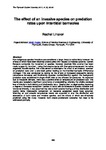The effect of an invasive species on predation rates upon intertidal barnacles
| dc.contributor.author | Linaker, R. | |
| dc.date.accessioned | 2019-05-15T08:49:54Z | |
| dc.date.available | 2019-05-15T08:49:54Z | |
| dc.date.issued | 2011 | |
| dc.identifier.citation |
Linaker, R. (2011) 'The effect of an invasive species on predation rates upon intertidal barnacles', The Plymouth Student Scientist, 4(2), p. 66-82. | en_US |
| dc.identifier.issn | 1754-2383 | |
| dc.identifier.uri | http://hdl.handle.net/10026.1/13950 | |
| dc.description.abstract |
Non-indigenous species invasions are considered a large threat to native biota however the effects of which have been relatively understudied with respect to intertidal systems. Current literature surrounds the movement of species, however relatively little attempt has been made to quantify the effect. Using the invasive oyster drill Ocenebra erinacea and the native dogwhelk Nucella lapillus, this study aimed to investigate the effect of an invasive species‟ on predation rates over a one-week period feeding on the intertidal barnacle Chthamalus montagui. This was conducted by testing for the effects of increased conspecific density (abundance increase) and biodiversity (species number/identity) against the background predation rates established in single whelk trials at two different temperatures. As expected due to metabolic demand, there was a positive effect of temperature on predation rate. The results also revealed a significant occurrence of underyielding, whereby the whelks predated less efficiently in both density and biodiversity tests. Despite plant or algal studies expecting a degree of increased ecosystem function to occur with an increase in species richness and functional diversity, it was assumed that due to both species having a similar distribution and trophic niche, interspecific competition for resource acquisition would have occurred. Warming air and oceanic temperature trends are expected to alter the distribution and abundance of both native and invasive species, and the effects of which are effectively predicted using this study. However, both create problematic scenarios that need to be addressed promptly. | en_US |
| dc.language.iso | en | en_US |
| dc.publisher | University of Plymouth | |
| dc.rights | Attribution 3.0 United States | * |
| dc.rights.uri | http://creativecommons.org/licenses/by/3.0/us/ | * |
| dc.subject | non-indigenous | en_US |
| dc.subject | species invasions | en_US |
| dc.subject | native biota | en_US |
| dc.subject | dogwhelk nucella lapillus | en_US |
| dc.subject | oyster drill Ocenebra erinacea | en_US |
| dc.subject | biodiversity | en_US |
| dc.subject | ecosystem | en_US |
| dc.subject | intertidal barnacle Chthamalus montagui | en_US |
| dc.title | The effect of an invasive species on predation rates upon intertidal barnacles | en_US |
| dc.type | Article | |
| plymouth.journal | The Plymouth Student Scientist |



